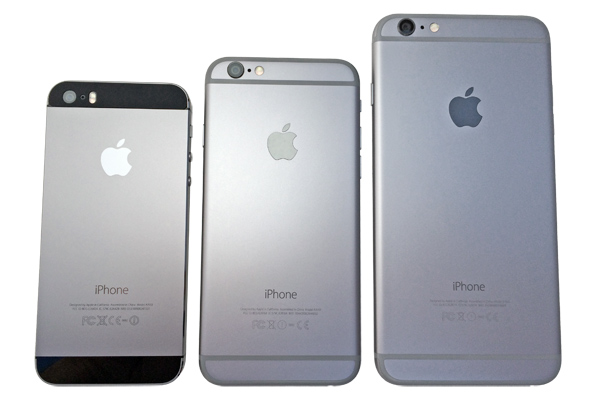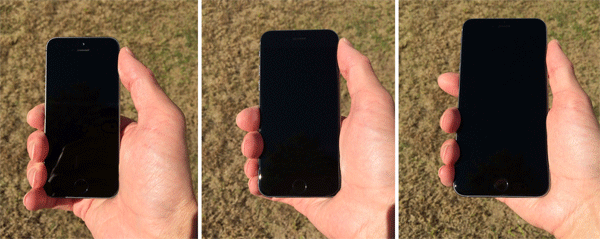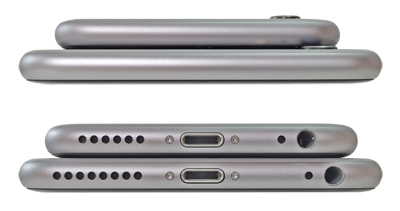Apple iPhone 6 And iPhone 6 Plus Review
The iPhone 6 and 6 Plus are bigger and better than ever, but are they a worthy upgrade for existing iPhone users? What if you previously passed over the iPhone because of its small screen, does it now merit a second look?
Why you can trust Tom's Hardware
iPhone 6 Look And Feel
The iPhone's industrial design is its most discernible feature, a combination of style, materials and build quality unmatched by other smartphones, making it one of the most lustworthy gadgets to stuff in a pocket. For the past four years the iPhone’s all-aluminum body had flat sides with sharp, angular edges. The new iPhone 6 and 6 Plus keep the all-aluminum chassis, but now the edges are rounded, giving the phones a smooth, sleek aesthetic.
The rounded profile improves the in-hand feel. Instead of the harsh feeling of sharp edges, the iPhone 6 seems to match the contour of the hand, eliminating uncomfortable pressure points. Combining the rounded edges with smooth aluminum creates a rather slippery device though, requiring a more astute grip.
The biggest design change isn’t the curved edges, but the larger screens they wrap around. Last year, Apple launched two different iPhones for the first time: the iPhone 5s and 5c. This year’s launch of the iPhone 6 marks the first time the iPhone comes in different sizes.
Since the shipment of our 6 Plus was delayed for two weeks, I spent some time at an Apple Store to get some early impressions. During the brief time I was there, about a dozen people approached the display table. Just like a page from the story of Goldilocks and the Three Bears, every one of them wanted to see the 6 Plus first, but after a quick glance, or picking it up and holding it briefly, all but one person said it was too big and slid over to the next station with an iPhone 6. While this experience is anecdotal, I suspect it extrapolates fairly well to the population at large. The novelty of seeing such a large iPhone draws people to the 6 Plus, but then they gravitate to the more practical iPhone 6.
With its 4.7-inch screen, the iPhone 6 seems to strike the perfect balance between screen size and portability. It’s lightweight, fits nicely in an average-sized hand and with just a little stretch, the entire screen is accessible with your fingers. It also slips easily into most pockets.
The 5.5-inch iPhone 6 Plus, on the other hand (or two), is a different beast. It’s impossible for anything but a Yeti to reach the upper portion of the screen, and the majority of pants pockets are an exclusion zone for the 6 Plus. I wouldn’t call it heavy, but the larger size gives it a noticeable heft. Fortunately, its mass is spread evenly, making it feel nicely balanced in-hand.
Since the appearance of both iPhones are identical, except for size, the descriptions below apply to both models.
Get Tom's Hardware's best news and in-depth reviews, straight to your inbox.
The entire front of the iPhone 6 is covered in glass, a radius running around its perimeter blending perfectly with the curved edges of the aluminum body, creating a seamless transition that makes swipe gestures feel fluid. Surrounding the LCD is a black bezel. It's thin on the sides, but a larger 16mm on the top and bottom. The round Home button, with integrated Touch ID sensor and color-matched stainless steel detection ring, sits below the screen, its appearance unchanged from the iPhone 5s. The Home button does seem to have a slightly more reassuring click in the iPhone 6 version. Above the screen is a thin slot for the phone’s earpiece. The front-facing camera moves back to the left side of the earpiece, no longer centered like it was in the iPhone 5 and 5s. The ambient light and proximity sensors reside above the earpiece.
Around back we see several tweaks to the iPhone 5/5s design. Gone are the colored plastic RF windows, replaced by semi-thick plastic antennae lines with aluminum inserts. The more controversial change is the protruding rear camera, which is a direct consequence of reducing the iPhone’s thickness. Still located in the upper-left corner, the camera’s sapphire lens is now encircled by a metal ring that sits less than one millimeter above the back plane of the phone. I don’t feel this is a big issue, but I do find myself setting the phone down more gently.
The True Tone Flash, to the right of the camera, is now slightly larger and circular. Sitting between the camera and flash is one of two microphones, this one used for noise cancellation. Of course, the back of an iPhone wouldn’t be complete without a shiny Apple logo.
The mute switch and volume buttons continue to occupy the top-left edge. They have a sturdy feel and a positive click. The power/lock button finds a new location on the top-right edge, putting it within easy reach on the taller iPhone 6. The new location feels very natural, but I find myself inadvertently pressing the volume buttons occasionally when turning the phone on or off. Below the power/lock button is the Nano-SIM tray.
There’s nothing but smooth aluminum along the top edge, while the 3.5mm headphone jack, microphone, Lightning connector and speaker all occupy the bottom edge.
Accessories
The iPhone 6 comes with the standard Apple accessories, including a 5W USB power adapter and Apple EarPods with inline remote and microphone.
-
blackmagnum Everyone would want to own one and be the envy of their peers. They want a device that is attractive, well-made and intuitive. That's how Apple sells them by the millions, don't you agree?Reply -
lanbaner Nvidia has a better GPU. The G3 has a better display. The Note 4 has better camera. Gone are the days were the iPhone was the leader on all fronts. Would be nice to see all the strengths from the competition in one phone. Considering the transition to 20nm for Maxwell early next year we could possibly see an iPhonekiller on all aspects. Although I have to agree that the build quality on the iPhones is always top notch.Reply -
M3God Other then just sticking to just 1GB internal memory, there is no mention that apple switched to cheaper and slower TLC memory to make more profits while screwing the customer. The TLC memory has been linked to crashes and bootloops that require a trip to the apple store.Reply -
aaaas I browse the Web and talk on the phone on Verizon all the time. At least the last two generations of devices have been able to do this... at least for android...Reply
Interesting article, as I've been considering a switch to iphone. -
KaptainK " Wi-Fi calling is currently only supported by T-Mobile in the U.S."Reply
Not True! Republic Wireless has been using wi-fi calling for years. Republic also includes a feature where it will hand the call off from wi-fi to cellular if you leave the wi-fi zone during the call. Does the iPhone do this?? -
cknobman A. Thanks for including the Lumia 1520 in the comparison chart of phablets, most other sites dont do this.Reply
B. The price for the 6 plus in that same chart ($299) is on contract while every other device price is off contract.
As a whole if you are an iPhone user I am sure you are happy with the changes made to the 6. Outside of that the iPhone "cool factor" ship has sailed and this wont be winning over many Android users. -
cmi86 How can this guy sit here and hump apples leg by saying the A8 should be competitive if not class leading when it's competition averages over 1Ghz higher clock speed and 2 more cores.... I know a lot of people doing reviews now a days feel obligated to shine up certain companies and make their products appear in a positive light. This is not that... this is a blatant lie.Reply -
SirKnobsworth How can this guy sit here and hump apples leg by saying the A8 should be competitive if not class leading when it's competition averages over 1Ghz higher clock speed and 2 more cores.... I know a lot of people doing reviews now a days feel obligated to shine up certain companies and make their products appear in a positive light. This is not that... this is a blatant lie.Reply
Clock speeds and core counts can be deceptive, the key point here being that Apple's Cyclone cores can execute about twice as many instructions per clock cycle as most of their competitors. This shows up in the benchmarks - the iPhone 6 and 6+ do very well in single threaded tests, though tend to lag behind competitors in multithreaded tests like physics. Note that this is also the approach that Nvidia is taking with their Denver cores - fewer, bigger cores as opposed to more small cores.
How this translates into actual performance will vary of course - most smartphone workflows aren't particularly well threaded so having four cores as opposed to two probably won't make a huge difference in many situations, but I'm sure there are plenty of exceptions. -
ZXS ReplyDue to their zero reading on the black level tests, AMOLED displays are said to have an infinite contrast ratio.
MATT, do you know this is Samsung's marketing BS?
Smartphone displays reflect about 6% of incoming light (which is much more than LCD backlight emits). Actual contrast of AMOLED is worse than that of LCD since the reflections are so high, but maximum brightness is much lower than that of LCD.







